|
Near synonyms, such as small/little and strong/powerful, are words that have similar
meanings, but different uses or distributions. Because they have
different uses, near synonyms often cannot be interchanged. At times
it’s difficult to explain to students the differences between near
synonyms, but the Corpus of
Contemporary American English (Davies, 2008-) may be used to
learn about the ways in which near synonyms vary and to provide material
for teaching.
The Corpus of Contemporary American English (COCA) is a
freely-available corpus, though registration is required. It contains
450 million words of American English in use from 1990–2012, and it is
balanced in two ways. First, it is balanced by genre; the corpus
contains five equal-sized sections of spoken, fiction, magazine,
newspaper, and academic texts. It is also balanced in the sense that
COCA includes 20 million words for each year from 1990–2013 (Davies,
2008-). These features of balance are important when using the corpus
for instructional purposes.
The interface for COCA allows for quite sophisticated searches,
but basic searching is rather straightforward. To get started with
COCA, a Brief Tour is available under Help. The tour guides the user
through various options on the search interface. As seen in Figure 1,
help for each section of the interface is available by clicking on the
question mark on the right side of the interface. Also, there are
several introductions to COCA available on YouTube.
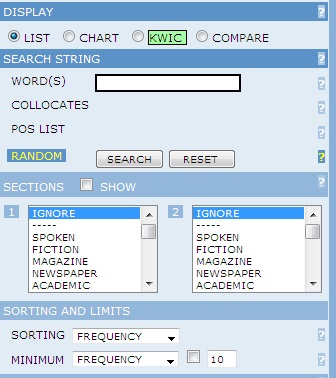
Figure 1. COCA basic search interface
One of the ways in which near synonyms differ is that their
collocates, or the words with which they commonly occur, differ. With
COCA, it’s easy to find the collocates of each near synonym and to
compare the collocates of two words. Referring again to Figure 1, there
are four options under display. “List” is the first option, and it can
be used to find collocates of a single word.
In Figure 2, the List is chosen, the word little is entered as a word to search for, and
“collocates” has been selected. These settings will result in a list of
words that occur frequently with little in a window,
or span, of four words to the left and four words to the right. These
words are collocates of little, and the reader will
recall that near synonyms often have different collocates. The five most
frequent collocates for little are given in Table 1.
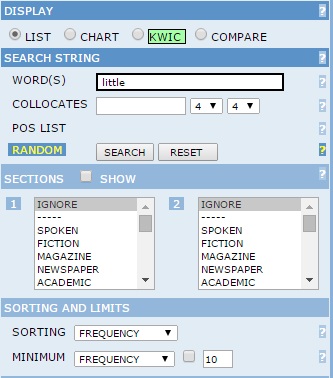
Figure 2. COCA interface to search for collocates of little
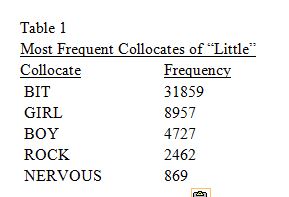
Table 1. Collocates of little
Note that the frequency of each collocate is also given. Bit occurs with little 31,859
times in COCA. There is a rapid fall off in frequency for the other
collocates; girl occurs only 8,957 with little, and nervous only 869
times.
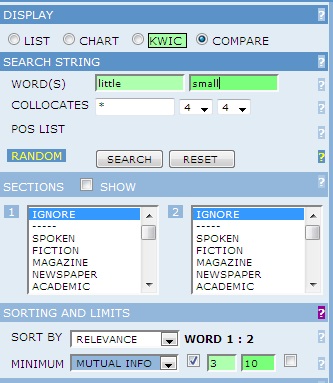
Figure 3. COCA interface to compare collocates of little and small
A useful feature of COCA is the ability to see how frequent a
collocate is with each of two near synonyms, compared to the overall
frequency of the two words. Figure 3 shows the interface setting for
this contrast. This time the “Compare” option was chosen, and in the
second search string field, “small” was entered. The relative frequency
of collocates for little and small
is given in Table 2. When examining Table 2, it is important to note
that none of the top 10 collocates for little appear
as one of the most frequent collocates for small, and
vice versa. That is, while in COCA funny appears 355
times as a collocate of little, it never appears as a
collocate of small. Likewise, saucepan appears as a
collocate of small 632 times, but never as a collocate of little.
Table 2. Relative frequency of collocates for little and small
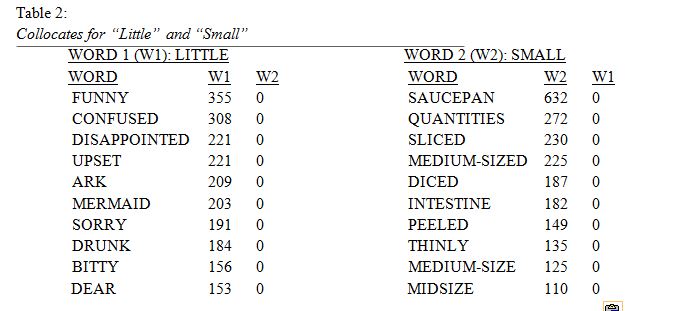
These lists provide a starting point for teaching the
collocates of near synonyms. It is easy to make a matching exercise with
the word lists. However, clicking on the W1 number for each collocate
provides a list of sentences with collocates. So, for funny, clicking on “355” results in 355 sentences
that could be used to create exercises. Some sentences would be too
difficult or otherwise inappropriate for use with students, but here are
five examples I selected from among the first 20 sentences:
- It's just kind of a funny little thing
- He's got a very, very funny little book
- He developed a funny little half smile.
- Funny little monkeys, aren't they?
- I found this funny little chair, marked "Snug-seat," at a tag sale.
Choosing sample sentences for several collocates of both
“little” and “small” would provide authentic material that could be
turned into a variety of sentence-level exercises.
Here is a second example using the near synonyms strong/powerful. The 10 most
relatively frequent collocates for strong and powerful are given in Table 3. The first thing to
note is that, again, none of the most frequent collocates are shared
between the two words, though some collocates of one word do appear
infrequently with the other. That is, showing, which
appears 217 times with strong, appears once with powerful, and weapon, which
appears as a collocate of powerful, occurs once with strong.
Table 3. Collocates of strong and powerful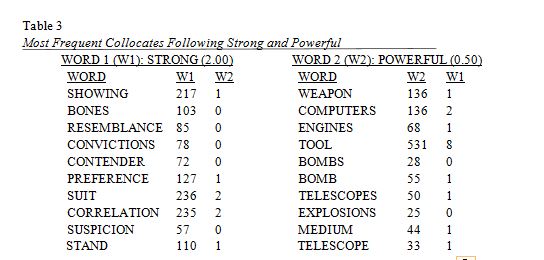
Another important feature to note is that several of the
collocates of powerful belong to the semantic sets of
machines and weapons, while those of strong do not.
That is, the collocates of each near synonym tend to have different
semantic associations. Using COCA to investigate the semantic
associations of the collocations of near synonyms will be the topic of a
future newsletter article.
References
Davies, M. (2008-). The corpus of contemporary
American English: 450 million words, 1990-present. Retrieved
from http://corpus.byu.edu/coca/.
Gee, Roger (2015-). Created by accessing from http://corpus.byu.edu/coca/
by the author. ( February 15th, 2015)
Roger W. Gee is a professor in the School of Education
at Holy Family University, where he is the director of the Masters in
TESOL and Literacy Program. He is interested in the use of language
corpora in teacher education. | 
